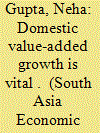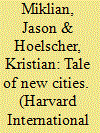| Srl | Item |
| 1 |
ID:
139322


|
|
|
| 2 |
ID:
147896


|
|
|
|
|
| Summary/Abstract |
Gains under the global value chains (GVCs) depend on how much of a country’s domestic value added (DVA) is passing onto other countries. However, India’s manufacturing sector is found to be hollowing out, that is, its DVA growth is declining. This article estimates the linkages of manufacturing sector into GVCs, focusing on machinery and textiles industries. It measures foreign value added in exports and gains under GVCs using intercountry input–output tables of OECD–WTO Trade in Value Added (TiVA) database (2015). TiVA shows a decline in India’s share of DVA exports in its gross exports. However, India has ‘net gains’ from linking into GVCs in the two industries as the ratio of forward linkages to backward linkages is greater than one. This indicates that value-added exports are greater than value-added imports. Thus, India has enough potential to compete with other countries in the upper ends of value chains in both its machinery and textiles industries.
|
|
|
|
|
|
|
|
|
|
|
|
|
|
|
|
| 3 |
ID:
132532


|
|
|
|
|
| Publication |
2014.
|
| Summary/Abstract |
The global shift from rural to urban living will be the most important demographic transformation of the 21st century. All great shifts create the opportunity for great fortunes, especially for those with audacious visions who are positioned to capitalize on them. Indian industrialist Ajit Gulabchand runs Hindustan Construction Company (HCC), which is responsible for some of the country's most iconic infrastructure projects. In what might be the single biggest bet in the history of Indian real estate, Gulabchand has staked HCC's future - and his own family fortune - on a cluster of five planned cities perched along artificial fjords about four hours east of Mumbai. He calls it Lavasa. 300 million people are projected to move into India's already overcrowded cities over the next quarter-century. Lavasa is Gulabchand's US$6 billion dollar attempt to capitalize on this demographic shift - and turn a profit in the process. He even modeled Dasve, the first of Lavasa's five cities, after Portofino on the Italian Riviera. Lavasa's sales team speaks of a "stirring adventure", complete with French lessons and rock climbing, for the 300,000 residents that it hopes to attract. With Indian cities feeling increasingly like pressure cookers, Lavasa's promise of clean air, sidewalks, and personal space attracted huge investments.
|
|
|
|
|
|
|
|
|
|
|
|
|
|
|
|